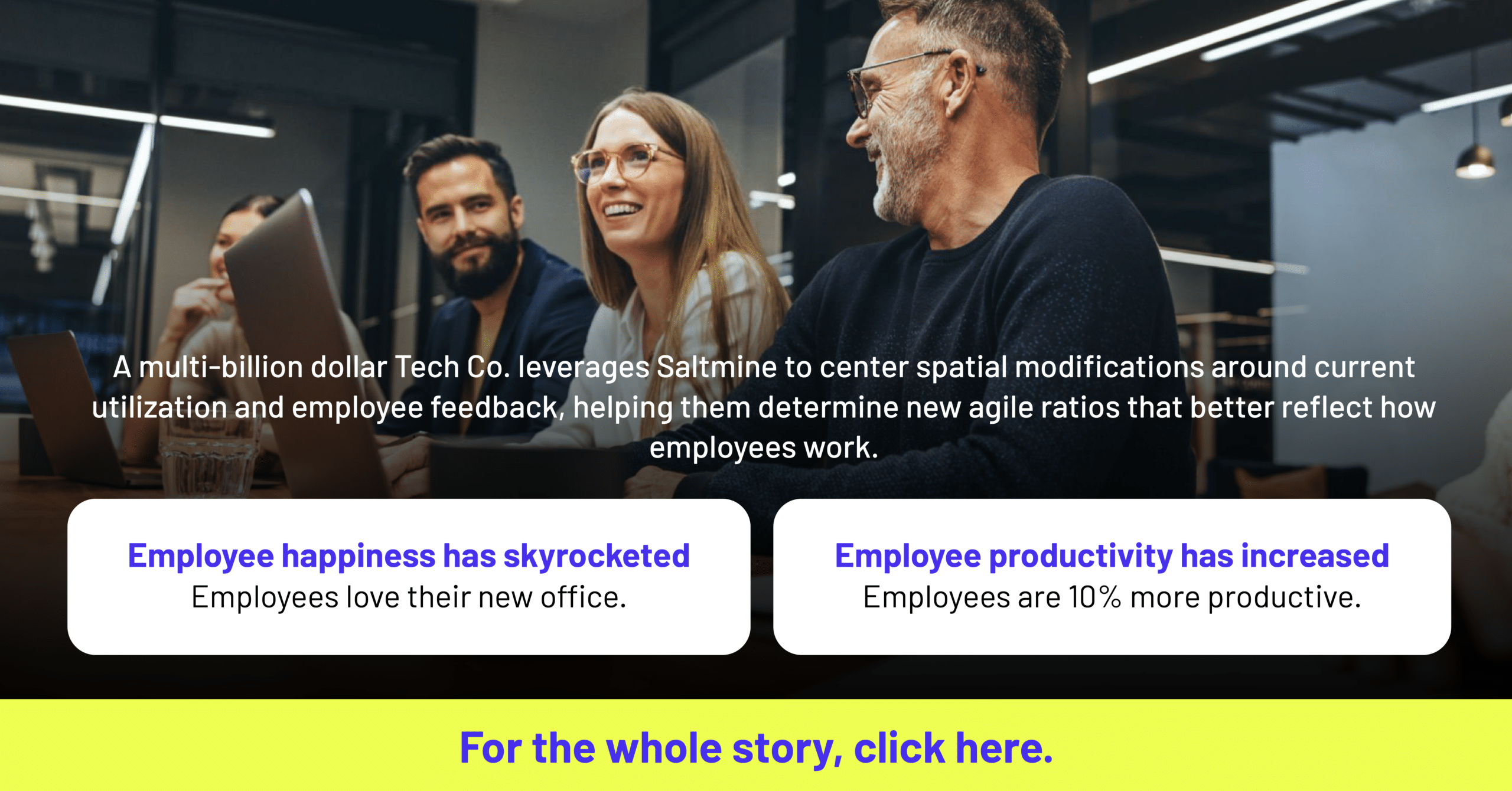Empower your organization by putting people at the forefront of workplace design and strategy. By deskilling the design process and allowing office end-users to influence capital projects, you can foster a truly democratic future of work.
All stakeholders across an organization should be a vital part of building a space they actually want to walk into every morning.
Whether you are the space planner or the office end-user, Saltmine allows workplace teams to achieve a truly democratic design process.
This happens in two major ways:
- Deskilling the design process to allow all stakeholders to have a hand and say in design.
- Providing every end-user—the employee—the opportunity to influence design decisions.
Deskilling the workplace design process
Not having the “right” hands on keyboards usually kills the pre-design, programming, and schematic design process. Design is not a “magic bullet” or another check off of the never ending list of best practices—design is a solution to a problem. A solution that should not fall on the shoulders of one single team.
Many space planners don’t have the technical design background—e.g., experience with design tools CAD, Revit, etc.—to go at this alone. These skills gaps affect the internal workplace team’s ability to independently move through the pre-design and design phase.
This results in the hiring of expensive external designers and architects, most of which need to be heavily integrated into the culture of the company to successfully design.
Contracting external designers isn’t out of the picture for most companies. Not having the ability to conduct workplace design in-house affects a team’s ability to execute a capital project in an effective or efficient fashion, resulting in lost time, money, and positive sentiment from your employees.
From siloed data points in inconsistent formats to lengthy floorplan iterations and expensive change orders, the skills gap of workplace design costs companies millions of dollars and thousands of hours every year.
Saltmine eliminates all this by reducing the level of skill needed to design in the first place.
With actionable data points, alongside housing all pre- and post-design floorplans under one accessible umbrella, Saltmine allows workplace teams to augment the design process.
You don’t need to be a skilled designer to learn how to design your company’s future workplace in Saltmine. By centralizing data and architectural plans in one place, workplace teams can make better decisions and execute capital projects faster than ever.
For example, Saltmine streamlines and bridges the gap between test fitting and visualization, resulting in substantial savings for many of our customers. One which includes an International Banking company who struggled with a lack of bandwidth and the specific technical expertise for test fitting:
Bottom line: Our cloud-based provides a faster and more accurate workflow that produces a realistic 3D digital twin of the architectural space—enabling faster and easier decision making throughout the entire design process.
Providing every employee the opportunity to influence design decisions
Many workplace design decisions are based solely on outside influence. With 68% of the US workforce desiring remote work over in-person environments, employees are expecting an office designed specifically for them to persuade them to return to office.
What works for Salesforce or Adobe, won’t work for every company. And while looking to successful workplace innovators for inspiration is great for brainstorming ideas, your workplace design should be rooted in how your people engage with their new workplace.
Many companies’ design attempts fail by designing based on assumptions or trends–not taking into account how the space makes employees feel, what it sounds like, accessibility features, modifications for neurodivergent employees, amenities, and so much more.
These large office buildings have traditionally been filled with rows of monotonous gray cubicles, harsh, overhead lighting, and cold desks filled with hard chairs. With this model, it should be no surprise that employees want to stay at home. There cannot be any inside-the-box thinking when designing the space where your employees spend most of their waking hours.
Getting your most important stakeholder—the employee—to put trust in your workplace design will define your office engagement. This makes granular employee sentiment data—that’s collected via a continual feedback loop—so crucial to designing your workplace of the future.
Having a firm grasp and understanding of the employee perception of the office is a key pillar of the Saltmine platform. Our Employee Heartbeat module allows workplace teams to get a “pulse” of employee sentiments and perceptions of space. This not only provides key insights on how spaces should evolve but allows employees to directly influence a capital project.
From the moment a floorplan is conceptualized in the early design phase, to when workers are utilizing the built environment—your people will create this space. Obtaining their positive, negative, and neutral feelings towards space must be the fuel for your workplace strategy and design’s engine.
People: The lifeblood of workplace design, strategy, and engagement
People are the lifeblood of any organization. It’s people who innovate and drive company culture.
Deskilling the design process and allowing the office end-user to influence capital projects, empowers organizations to fully democratize their future of work.
Leverage Saltmine and put people in the driver’s seat of workplace design and strategy. Allow them to be the lead designer of their workplace.
Want to know how Saltmine helps workplace teams accomplish this? Click the button below to learn more:
Enjoying our blog? Be sure to subscribe to stay up-to-date on Saltmine's original content with the form below!

 by
by 

